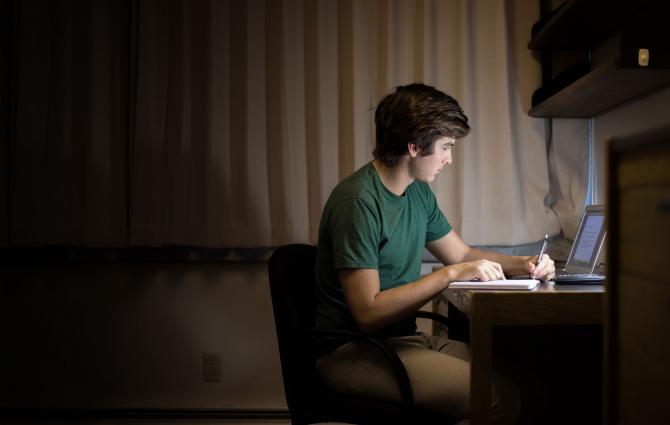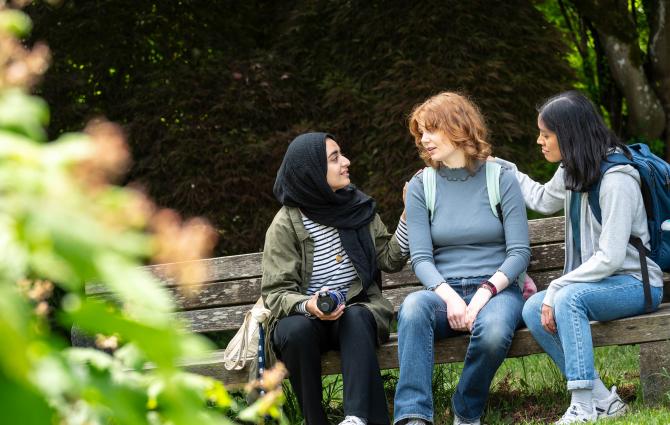When you feel well, you learn more effectively. UBC profs like Dr. Neil Armitage are designing classrooms with your wellbeing in mind.
For Dr. Armitage, student wellbeing starts with his students feeling comfortable in his classroom—and that involves getting to know them and encouraging them to get to know one another.
His goal is to create a classroom environment that fosters connection and support, and provides students with a safe and comfortable space where effective learning can happen.
What inspired you to design your curriculum and classroom activities to better support your students?
First and foremost, I wanted to get to know my students. There is a great distance at times, between students and their professors, and I wanted to reduce this.
I teach Sociology of Family and will often talk about my own personal experience and integrate life stories into my lecture. I also encourage my students to share their experiences and bring different perspectives to the classroom.
I like to be as transparent with my students as possible—I’m an open book with them and I feel that if I’m open with them, they will be open as well.

Why do you think it’s important to integrate wellbeing into your classroom?
If a student is not comfortable and secure in their environment, the learning won’t happen. Feeling a sense of belonging is a very foundational thing and I believe it is very important for me to help create this sense of belonging by getting to know my students and providing them with opportunities to get to know one another.
I teach 100- and 200-level sociology courses, which tend to be large and can feel impersonal so I try to make myself as approachable as possible and to make it easy for students to connect with me.
I’ll have office hours directly after class to encourage them to come see me and ask questions. I get to know their names by having them write them on a placard and display it in class—this way they get to know one another’s names as well.
I also admit when I don’t know something. Students here are very eager and it’s important to teach them that it’s ok to show the limits of knowledge—that’s normal. If they are good scholars, they need to know their limitations and to feel secure that not knowing isn’t always a problem—it allows us to go through the process of finding an answer together.
It’s easy to think that students just want to get As, but I see that they are eager to learn and grow.
What is a big challenge to wellbeing that students at UBC face? How do you try to address this in your teaching?
Students here are very isolated in a sense, and this is often perpetuated in our classrooms. There is nothing worse as an instructor than looking out into a big group of students and just having them listen to your voice, not engaging with you or with one another. I find the most meaningful work happens with collaboration.
Most individual assignments are written—our educational system favours this type of work, but it is not always the most conducive to relationship-building. I tend to include group activities that are linked to an individual assignment to encourage students to participate and to work together.
I did a lot of this type of work during my own undergraduate degree and it helped me learn how to work effectively in collaborative situations, which is a life skill that they will need when they begin their careers. Mixing up groups helps them get to know one another and how to work with different types of people.

Another challenge is that there is an inequity between commuter students and on-campus students.
Commuter students might be spending hours a day in transit and may not be able to participate as easily in campus life. So many students are doing so much in the way of extracurricular activities, but a student whose opportunity is limited by time or distance may feel they aren’t able to do what they need to do to get ahead—this is toxic to their wellbeing. Not only are they competing in the classroom, but outside it for informal skills as well.
I try to level the playing field and make things more equitable by incorporating exercises into the classroom that they can use outside as well.
For example, for final assignments I give them options—they can do a poster presentation, a case study essay, a lit review; something that best suits their skills or workload and that hopefully can be used outside of the classroom to participate in activities like MURCs (Multi-Disciplinary Undergraduate Research Conferences).
This way they don’t have to try and do this work on top of their regular school work—it is already a part of it.
What do you see as your role supporting wellbeing at UBC?
I work with students in two capacities—I am a sociology professor but also work at the CSI&C (Centre for Student Involvement and Careers) as a Learning Strategist, so I am involved in other facets of student development—orientation, leadership training, seminars, etc. It’s my job to give them a safe space for trial and error, which reflects the scientific method and curiosity.
Too often we look at a problem as front facing: thinking that the issue is the individual and that they need to change, rather than looking at what is happening in the environment to cause these issues, for example, stress and anxiety.
Our environment needs to be proactive, rather than reactive, and change to best support our students and their growth and wellbeing.
There is a responsibility when working in student services to look at what we are doing and to change if necessary. We want to produce excellent students and critical thinkers, but we need to supply them with a secure, safe, and encouraged environment in which to build these skills and we need to display critical thinking in our own work to do so.
To read the full interview, visit UBC Wellbeing.




